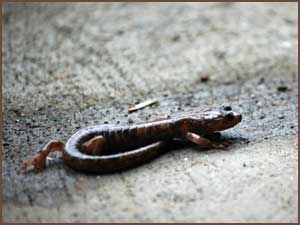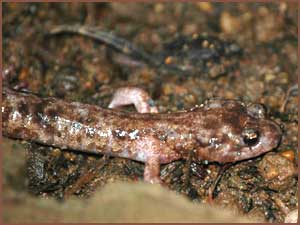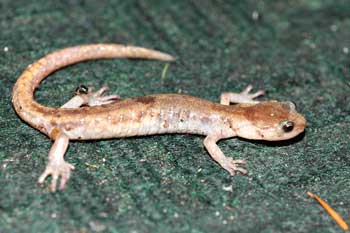Salamanders
Salamander Video Clips

Clouded Salamanders (Aneides ferreus) feed on ants, termites and other small invertebrates helping to maintain a balanced eco-system in your backyard.
The Climbing Salamander
The lungless Clouded Salamander is known as the "climbing salamander." With the help of the prehensile tail and the square tips on its long, broad toes, it can climb 6 meters (20 feet) high in trees. Notice the squarish tips on the toes in the following picture.

Their name is derived from the coloring on their sides and backs. They have large, protruding eyes. Their skin is smooth with distinct costal grooves. The mouth curves up behind the eyes giving the appearance that the salamander is smiling.

Habitat
In wet weather, they are nocturnal and usually very active. During dry weather, they often can become communal and group together inside decaying logs. They enjoy damp mossy areas, rotten logs, leaf litter or deep rocky crevices.
Reproduction
During courtship, males use their "mental gland" which located under the chin. He stimulates the female by rubbing this heart shaped gland over her snout. Unlike most salamanders that lay their eggs in water, the Clouded Salamander lays her eggs in rotting logs, preferably Douglas-fir in late spring or early summer. She stays with the eggs until they hatch. If any eggs become infected with fungus, she eats the fungus-egg to keep the fungus from spreading. In 9 weeks, fully formed young emerge ready to fend for themselves.
Salamander Shelter

It was on November 15, 2006, around 9:30 PM, when we saw an adult Clouded Salamander in our enclosed breezeway where it was sheltered from the outside rain and windy weather of the Pacific Northwest. After posing for the picture, the salamander crawled under the entrance step to hide. For over a month, when we looked out the door into the breezeway, we saw the salamander peeking out from under the entrance step. When we opened the door to go out into the breezeway, the salamander would duck back under the step and hide until the coast was clear.
Because the salamander was staying inside the enclosure and in a sheltered situation, we decided to set out a dish of water. It was just a couple of days after setting out the dish of water that we noticed the dish of water had debris in it every morning. Then, on December 19, 2006, at 12:45 AM, the adult Clouded Salamander was "zoned out" in the dish of water. The salamander was not drinking the water - the salamander had its whole body, head to tail, submerged under water. What a cool thing to see! It appeared to be sleeping.
A few days after seeing this remarkable sight, I was getting ready to go outside at o'dark thirty to feed the chippies, bunnies and birds. When I opened the door, I noticed the salamander was "zoning out" in the water dish again. I immediately turned around and shut the door. As the morning darkness progressed into daylight, the salamander started moving back and forth as though it was waking up. We turned on the overhead light and took a video of the salamander in the water dish.
Clouded Salamander with Extra Limb
On January 3, 2007, around 8 PM, we saw a juvenile Clouded Salamander next to the entrance step. This little salamander was no bigger than 1 inch. We originally thought some debris was stuck to the salamander, but upon closer observation, there is an extra arm that lays over the back of its head. This arm has a fin-like end. As you can see in the video, the salamander lifts the end of its fin-like limb up in the air. It appears polymelia is not common with salamanders, especially the Clouded Salamander because they lay their eggs on land and in shaded places. So, it is a mystery as to what caused this abnormality.
Compare the difference in size between the juvenile with the extra limb and the adult Clouded Salamander.

Size of Juvenile

Size of Adult
As of March 25, 2007, we still have a salamander living under the porch step. Every night the salamander soaks in the dish of water and often leaves a poop behind. Needless to say, we keep the "sally tub" clean with fresh water on a daily basis. We feel so fortunate that nature has given us this glimpse into the world of the Clouded Salamanders.
